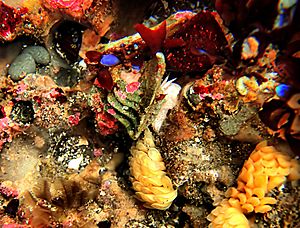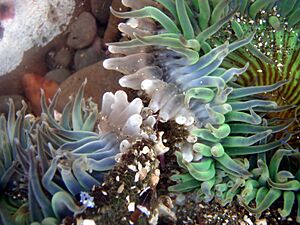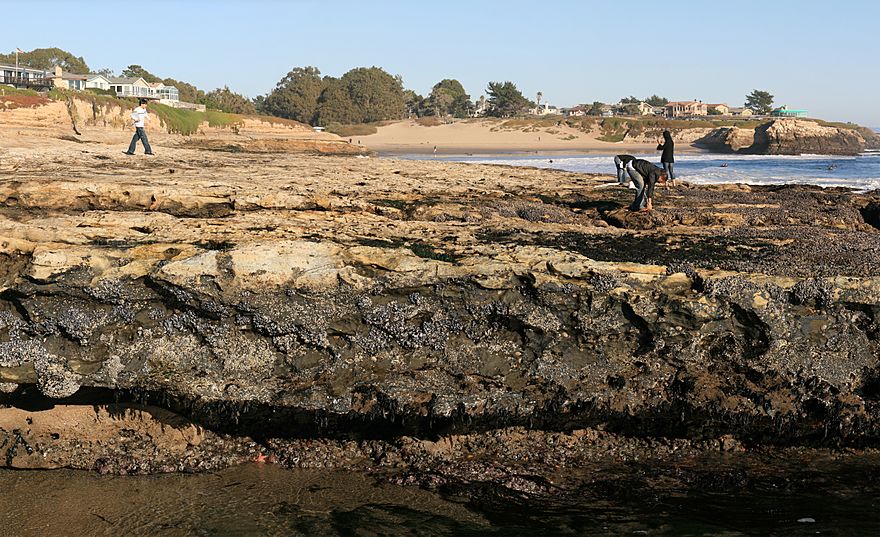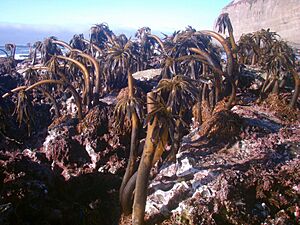Rock pool facts for kids
Rock pools (also called 'tide pools') are small pools of seawater found on rocky coastlines. They are located in the intertidal zone, which is the area between the high tide and low tide marks. When the tide is high, these pools are covered by the sea. But when the tide goes out, they become separate pools, trapping seawater and the amazing creatures that live there.
Tide pools are special homes, or habitats, for animals that have learned to adapt to a constantly changing world. Scientists who study the ocean, called marine biologists, find these creatures very interesting.
Contents
Life in a Rock Pool
Rock pools are home to tough organisms like starfish, mussels, and clams. These animals must be able to handle big changes in their environment. This includes changes in water temperature, how salty the water is (called salinity), and how much oxygen is in the water.
Huge waves, strong currents, being exposed to the hot sun at midday, and predators are just some of the dangers that rock pool animals face. For example, strong waves can pull mussels off the rocks and out to sea. Gulls sometimes pick up sea urchins and drop them to break their shells. Starfish eat mussels, and gulls eat starfish! Even black bears have been known to snack on creatures in the intertidal zone when the tide is low.
Even though rock pool organisms must avoid being washed away, drying out in the sun, or being eaten, they actually depend on the tide pool's constant changes for their food.
Different Zones of a Rock Pool
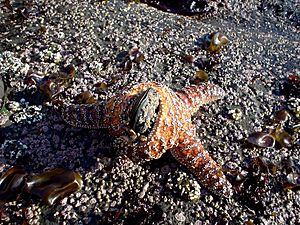
The Splash Zone
This zone is the highest part of the intertidal area. It mostly gets wet from ocean spray during high tides and storms. At other times, the rocks here face extreme conditions, like baking in the sun or being exposed to cold winds. Not many organisms can survive such harsh conditions. You might find lichens and barnacles living here. Different types of barnacles live at very specific heights in this zone, depending on the exact tidal conditions.
Since the intertidal zone often dries out when the tide is low, barnacles are very good at dealing with water loss. Their shells are made of calcite and don't let water through. They also have two plates that they can slide across their mouth when they are not feeding. These plates also help protect them from predators.

The High Tide Zone
The high tide zone is covered by water for several hours during each high tide. Organisms here must survive strong waves, currents, and being exposed to the sun when the tide is out. This zone is home to sea anemones, starfish, chitons, crabs, green algae, and mussels. Marine algae can offer shelter for creatures like nudibranchs and hermit crabs. The same waves and currents that make life tough in this zone also bring food to animals that filter feed and other intertidal creatures.
The Low Tide Zone
This area is almost always underwater. It is only exposed to the air during very low tides. This zone is full of life! There is much more marine plant life, especially seaweed. You'll find a greater variety of living things here, but these organisms are not as good at handling dryness or extreme temperatures.
Animals in the low tide zone include abalone, sea anemones, brown seaweed, chitons, crabs, green algae, hydroids, isopods, limpets, mussels, nudibranchs, small fish, sea cucumbers, kelp, sea stars, sea urchins, shrimp, snails, sponges, sea grasses, tube worms, and whelks.
These creatures can grow larger because there is more food and better water coverage. The water is shallow enough for lots of light to reach plants for photosynthesis. Also, the salinity (saltiness) of the water is almost normal here. This area is still protected from very large predators because of the constant wave action and the relatively shallow water.
Amazing Rock Pool Creatures

Rock Pool Animals: Reproduction and Life Cycle
Some Sea anemones, like Anthopleura elegantissima, can make copies of themselves through a process called longitudinal fission. This is when the animal splits into two parts along its length.
Other species, such as Anthopleura sola, can actually fight for their territory! They use special white tentacles called acrorhagi, which contain stinging cells. The sea anemones sting each other repeatedly until one of them (usually) moves away.
Some types of starfish can regrow lost arms over time. Most species need to keep their central body part intact to regenerate, but a few can regrow from just one arm. This amazing ability is possible because their important organs are located in their arms.
Rock Pool Plants
Sea palms look a lot like palm trees. They live in the middle to upper intertidal zones where there is a lot of wave action. Strong waves can bring more nutrients to the sea palms and move their blades, allowing more sunlight to reach them for photosynthesis. The constant wave action also helps by removing other plants that might compete for space.
Images for kids
-
The site of a tide pool in Santa Cruz, California showing sea stars, sea anemones, and sea sponges.
-
A tide pool in Porto Covo, west coast of Portugal
See also
 In Spanish: Pozas de marea para niños
In Spanish: Pozas de marea para niños


